英语ppt《论中国教育优势与劣势》.
- 格式:ppt
- 大小:1.46 MB
- 文档页数:13

中国教育的利弊英语作文The advantages and disadvantages of Chinese education are complex and multifaceted. On the one hand, the Chinese education system emphasizes discipline, hard work, and academic excellence. This has led to a highly competitive environment that produces many high-achieving students. Additionally, the focus on basic skills such as math, science, and language arts has resulted in a strong foundation in these areas for many Chinese students.However, this emphasis on rote memorization and standardized testing has also been criticized for stifling creativity and critical thinking. Many argue that the Chinese education system places too much pressure on students, leading to high levels of stress and anxiety. Furthermore, the focus on test scores and academic performance has been accused of neglecting the importance of holistic development and individualized learning.Despite these criticisms, it is important to recognize that the Chinese education system has also undergone significant reforms in recent years. Efforts have been made to promote a more well-rounded education that includes art,music, physical education, and other extracurricular activities. Additionally, there has been a growing recognition of the need to nurture creativity and innovation in students, rather than solely focusing on rote learning.Overall, while the Chinese education system has its strengths and weaknesses, it is important to continue striving for improvement and reform in order to provide the best possible educational experience for all students.中国教育的利弊是复杂而多方面的。
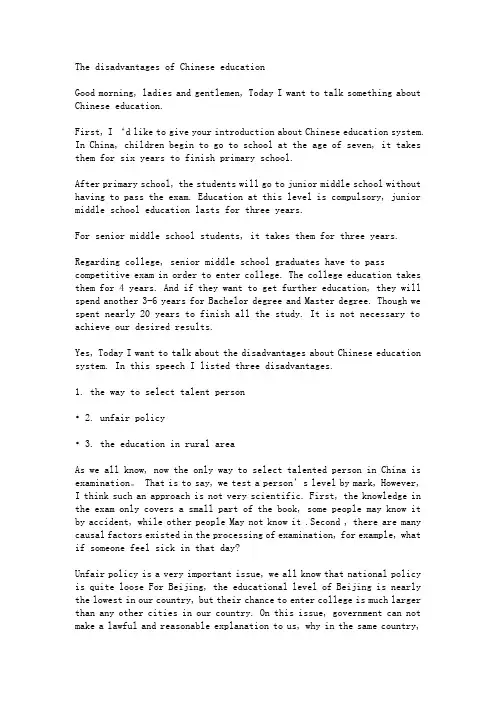
The disadvantages of Chinese educationGood morning, ladies and gentlemen, Today I want to talk something about Chinese education.First, I ‘d like to give your introduction about Chinese education system. In China, children begin to go to school at the age of seven, it takes them for six years to finish primary school.After primary school, the students will go to junior middle school without having to pass the exam. Education at this level is compulsory, junior middle school education lasts for three years.For senior middle school students, it takes them for three years.Regarding college, senior middle school graduates have to pass competitive exam in order to enter college. The college education takes them for 4 years. And if they want to get further education, they will spend another 3-6 years for Bachelor degree and Master degree. Though we spent nearly 20 years to finish all the study. It is not necessary to achieve our desired results.Yes, Today I want to talk about the disadvantages about Chinese education system. In this speech I listed three disadvantages.1. the way to select talent person• 2. unfair policy• 3. the education in rural areaAs we all know, now the only way to select talented person in China is examination。
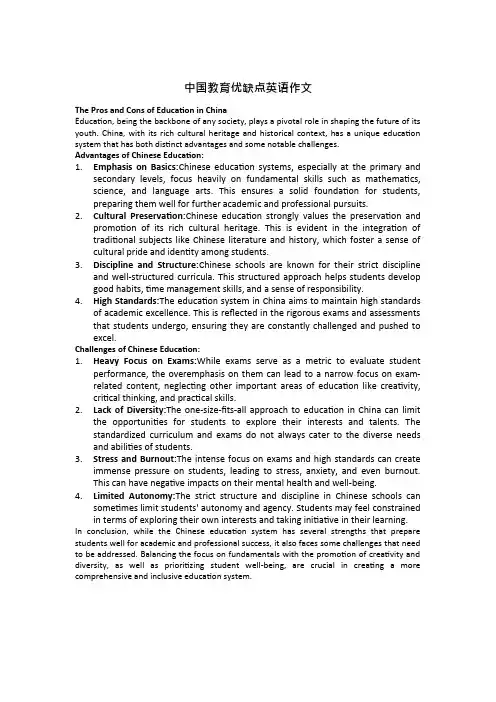
中国教育优缺点英语作文The Pros and Cons of Education in ChinaEducation, being the backbone of any society, plays a pivotal role in shaping the future of its youth. China, with its rich cultural heritage and historical context, has a unique education system that has both distinct advantages and some notable challenges.Advantages of Chinese Education:1.Emphasis on Basics:Chinese education systems, especially at the primary andsecondary levels,focus heavily on fundamental skills such as mathematics, science,and language arts.This ensures a solid foundation for students, preparing them well for further academic and professional pursuits.2.Cultural Preservation:Chinese education strongly values the preservation andpromotion of its rich cultural heritage.This is evident in the integration of traditional subjects like Chinese literature and history, which foster a sense of cultural pride and identity among students.3.Discipline and Structure:Chinese schools are known for their strict disciplineand well-structured curricula. This structured approach helps students develop good habits, time management skills, and a sense of responsibility.4.High Standards:The education system in China aims to maintain high standardsof academic excellence. This is reflected in the rigorous exams and assessments that students undergo, ensuring they are constantly challenged and pushed to excel.Challenges of Chinese Education:1.Heavy Focus on Exams:While exams serve as a metric to evaluate studentperformance, the overemphasis on them can lead to a narrow focus on exam-related content, neglecting other important areas of education like creativity, critical thinking, and practical skills.ck of Diversity:The one-size-fits-all approach to education in China can limitthe opportunities for students to explore their interests and talents.The standardized curriculum and exams do not always cater to the diverse needs and abilities of students.3.Stress and Burnout:The intense focus on exams and high standards can createimmense pressure on students, leading to stress, anxiety, and even burnout.This can have negative impacts on their mental health and well-being.4.Limited Autonomy:The strict structure and discipline in Chinese schools cansometimes limit students' autonomy and agency. Students may feel constrained in terms of exploring their own interests and taking initiative in their learning.In conclusion,while the Chinese education system has several strengths that prepare students well for academic and professional success, it also faces some challenges that need to be addressed. Balancing the focus on fundamentals with the promotion of creativity and diversity,as well as prioritizing student well-being,are crucial in creating a more comprehensive and inclusive education system.。
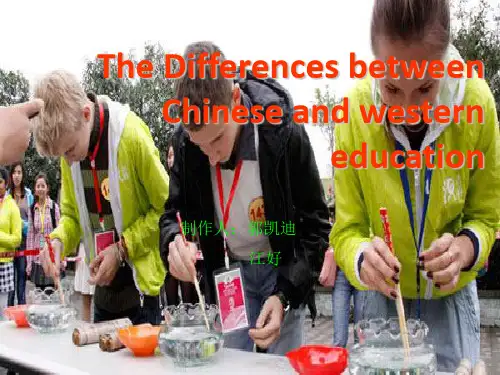
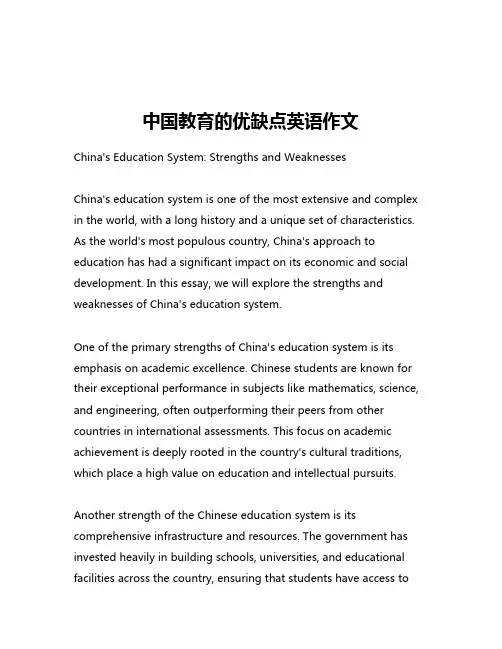
中国教育的优缺点英语作文China's Education System: Strengths and WeaknessesChina's education system is one of the most extensive and complex in the world, with a long history and a unique set of characteristics. As the world's most populous country, China's approach to education has had a significant impact on its economic and social development. In this essay, we will explore the strengths and weaknesses of China's education system.One of the primary strengths of China's education system is its emphasis on academic excellence. Chinese students are known for their exceptional performance in subjects like mathematics, science, and engineering, often outperforming their peers from other countries in international assessments. This focus on academic achievement is deeply rooted in the country's cultural traditions, which place a high value on education and intellectual pursuits.Another strength of the Chinese education system is its comprehensive infrastructure and resources. The government has invested heavily in building schools, universities, and educational facilities across the country, ensuring that students have access toquality education regardless of their geographic location. This has contributed to the high enrollment rates and the overall accessibility of education in China.Additionally, the Chinese education system is known for its emphasis on discipline, hard work, and perseverance. Students are expected to put in long hours of study, often with the support of their families and the broader community. This culture of diligence and dedication has been instrumental in producing a highly skilled and hardworking workforce, which has been a key driver of China's economic growth.However, the Chinese education system is not without its weaknesses. One of the primary criticisms is its overemphasis on rote learning and standardized testing. Students are often required to memorize large amounts of information and regurgitate it during exams, rather than developing critical thinking and problem-solving skills. This approach can stifle creativity and limit the ability of students to adapt to the rapidly changing demands of the modern workforce.Another weakness of the Chinese education system is its lack of flexibility and individualization. The curriculum is highly standardized, with little room for students to pursue their own interests or explore alternative learning paths. This can be particularly challenging for students with unique learning needs or those who do not fit themold of the traditional academic system.Furthermore, the intense academic pressure and the high-stakes nature of the education system in China can have negative impacts on the mental health and well-being of students. The constant pressure to excel academically can lead to high levels of stress, anxiety, and even depression among young people, which can have long-lasting consequences on their overall development and quality of life.Despite these weaknesses, it is important to acknowledge that the Chinese education system has also undergone significant reforms and improvements in recent years. The government has recognized the need to foster more creativity, critical thinking, and well-rounded development among students, and has implemented various initiatives to address these issues.For example, the introduction of more project-based learning, the incorporation of more diverse assessment methods, and the emphasis on developing soft skills like communication and teamwork have all been efforts to address the limitations of the traditional education system. Additionally, there have been increased investments in mental health support and counseling services for students, recognizing the importance of holistic student development.In conclusion, China's education system is a complex and multifaceted entity, with both strengths and weaknesses. While the focus on academic excellence and the comprehensive infrastructure have contributed to the country's economic and social progress, the overemphasis on standardized testing and the lack of flexibility have also posed significant challenges. As China continues to evolve and adapt to the changing needs of the 21st century, it will be crucial for its education system to strike a balance between academic rigor and the development of well-rounded, creative, and adaptable individuals who can thrive in the global landscape.。
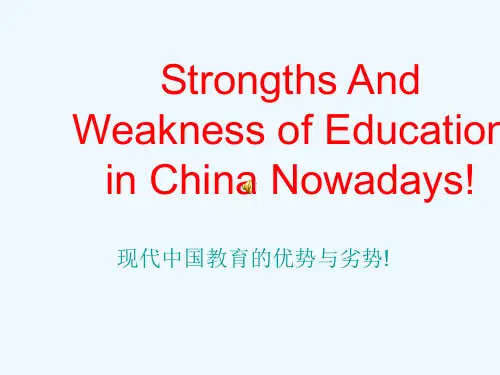

2000年第23卷第3期 辽宁师范大学学报(社会科学版)Jou rnal of L iaon ing N o rm al U n iversity(Social Science)2000V o l.23№3论中国教育发展的优势与劣势于钦波(辽宁师范大学教育科学研究所,辽宁大连 116029)α摘 要:不同的国家、地区,不同的社会和不同的时代,其教育发展的优势和劣势也不尽相同。
现代中国教育发展的优势在于:确立了教育优先发展的指导思想;建立了实验基地和教育科研队伍及适合中国国情的教育管理体制。
其劣势在于:存在着固执的华夏文化中心主义;小农经济思想阻碍现代办学体制的形成与发展;教育负担沉重。
这需要我们探讨如何发挥其优势,克服和摆脱劣势,以开创中国现代教育发展的新路子。
关键词:教育发展;优势;劣势中图分类号:G40 文献标识码:A 文章编号:100021751(2000)0320001204On Advan tages and D isadvan tages of Educa tiona l D evelopm en t i n Ch i naYU Q in2bo(E d uca tion S cience Institu te,L iaon ing N or m a l U n iversity,D a lian116029,Ch ina)Abs tra c t:T he advan tages and disadvan tages of educati onal developm en t vary in differen t coun tries and in differen t ti m es.T he advan tages of educati onal developm en t in modern Ch ina are as fo llow s:it has a gu iding ideo logy of giving p ri o rity to educati onal developm en t,experi m en tal bases,researchers and an educati onalm anagem en t system w ith Ch inese characteristics. T he ob stinate belief that Ch inese cu ltu re is cen tral,the ideo logy of s m all2scale peasan t econom y and heavy educati onal bu rden t are its disadvan tages.T herefo re it is necessary fo r u s to exp lo re w ays to exp lo it the advan tages and overcom e the disadvan tages so as to develop modern Ch inese educati on.Ke y w o rds:educati onal developm en t;advan tages;disadvan tages一教育的基本职能决定了它是人类社会延续和不断向前发展的基本条件,没有教育,就没有人类社会的今天,而且随着人类社会文明程度的提高和教育的政治、经济、文化功能的增强,社会一方面对教育不断提出更新、更高的要求;另一方面,社会对教育的依赖性也越来越强,特别是在现代化社会中,科学和教育已成为现代社会发展的两大支柱。
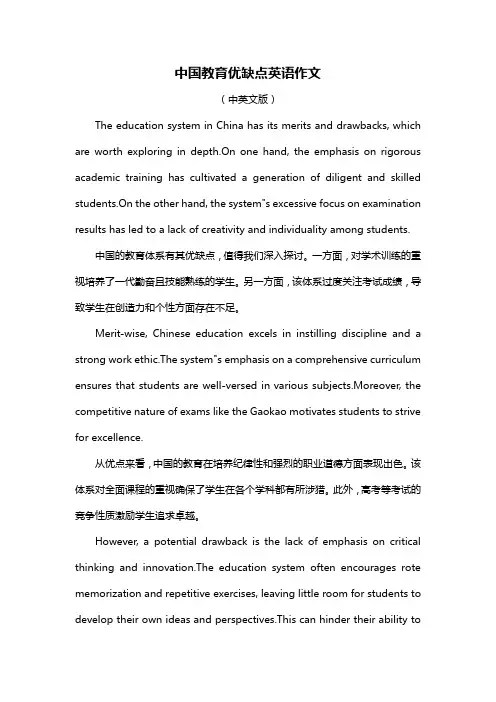
中国教育优缺点英语作文(中英文版)The education system in China has its merits and drawbacks, which are worth exploring in depth.On one hand, the emphasis on rigorous academic training has cultivated a generation of diligent and skilled students.On the other hand, the system"s excessive focus on examination results has led to a lack of creativity and individuality among students.中国的教育体系有其优缺点,值得我们深入探讨。
一方面,对学术训练的重视培养了一代勤奋且技能熟练的学生。
另一方面,该体系过度关注考试成绩,导致学生在创造力和个性方面存在不足。
Merit-wise, Chinese education excels in instilling discipline and a strong work ethic.The system"s emphasis on a comprehensive curriculum ensures that students are well-versed in various subjects.Moreover, the competitive nature of exams like the Gaokao motivates students to strive for excellence.从优点来看,中国的教育在培养纪律性和强烈的职业道德方面表现出色。
该体系对全面课程的重视确保了学生在各个学科都有所涉猎。
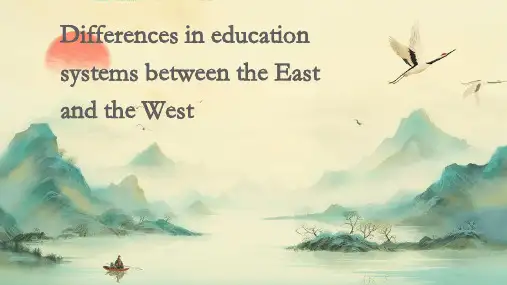
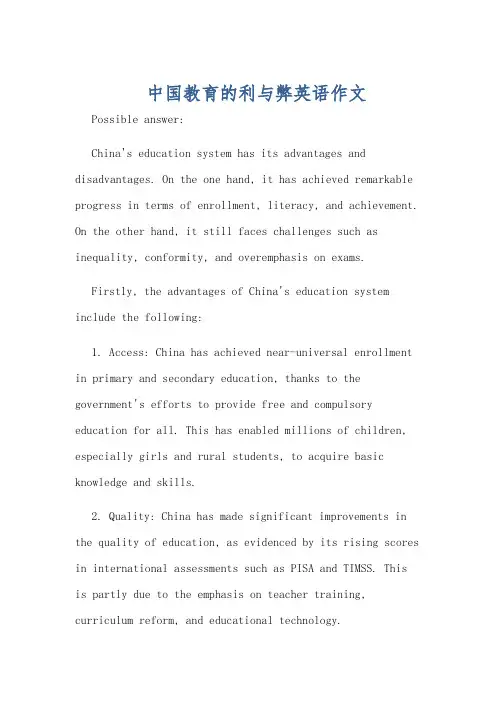
中国教育的利与弊英语作文Possible answer:China's education system has its advantages and disadvantages. On the one hand, it has achieved remarkable progress in terms of enrollment, literacy, and achievement. On the other hand, it still faces challenges such as inequality, conformity, and overemphasis on exams.Firstly, the advantages of China's education system include the following:1. Access: China has achieved near-universal enrollment in primary and secondary education, thanks to the government's efforts to provide free and compulsory education for all. This has enabled millions of children, especially girls and rural students, to acquire basic knowledge and skills.2. Quality: China has made significant improvements in the quality of education, as evidenced by its rising scores in international assessments such as PISA and TIMSS. Thisis partly due to the emphasis on teacher training, curriculum reform, and educational technology.3. Diversity: China has a diverse range of educational institutions, from public to private, from academic to vocational, from urban to rural, from traditional to innovative. This allows students to choose the type of education that suits their interests and needs.Secondly, the disadvantages of China's education system are as follows:1. Inequality: China still has a significant gap in educational opportunities and outcomes between urban and rural areas, between coastal and inland regions, and between different social classes. This reflects the unequal distribution of resources, such as funding, teachers, and facilities.2. Conformity: China's education system tends to emphasize conformity and obedience over creativity and critical thinking. This is reflected in the rote memorization, rigid discipline, and standardized testing that dominate the classroom. This may stifle students' curiosity, imagination, and initiative.3. Pressure: China's education system puts a lot of pressure on students to achieve high scores in exams,especially the national college entrance exam (gaokao).This can lead to stress, anxiety, and even depression among students, as well as competition, cheating, and corruption among schools and parents.In conclusion, China's education system has bothstrengths and weaknesses, and there is no simple solutionto its challenges. However, by building on its achievements and addressing its shortcomings, China can strive for amore inclusive, innovative, and sustainable educationsystem that benefits all its citizens.中文翻译:中国的教育系统有其优点和缺点。
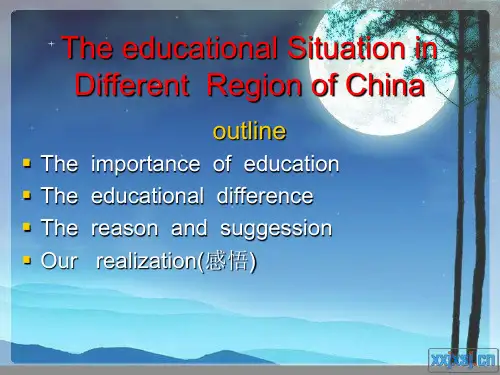
中国教育的利与弊**The Pros and Cons of Chinese Education**Education is the backbone of any society, shaping the minds and futures of its youth. China, with its rich cultural heritage and historical context, has developed a unique educational system that has both distinct advantages and challenges. This essay aims to delve into the pros and cons of Chinese education, focusing on key aspects such as curriculum content, assessment methods, teacher-student relationships, and the role of technology.**Curriculum Content: Depth and Breadth**The Chinese education system is renowned for its emphasis on academic excellence and the depth of knowledge imparted. Students are expected to master a broad range of subjects, including traditional Chinese culture, history, and languages. This approach cultivates a strong foundation in literacy, numeracy, and critical thinking. However, the rigidity of the curriculum can sometimes limit students' exposure to subjects outside the traditional academic sphere, such as the arts, sports, and entrepreneurship.**Assessment Methods: Standardized Testing**Standardized testing plays a pivotal role in Chinese education, often determining students' progress and future opportunities. These exams, such as the Gao Kao, are highly competitive and require meticulous preparation. While they ensure fairness and objectivity in assessment, they can also create immense pressure and anxiety for students. The overemphasis on test scores can lead to a narrow focus on rote learning and neglect of creative thinking and problem-solving skills.**Teacher-Student Relationships: Authority andRespect**In Chinese classrooms, teachers are often accorded high respect and authority. This hierarchical structure ensures discipline and order, but it can also stifle open communication and critical dialogue. Students are encouraged to adhere strictly to instructions and avoid challenging authority, which may hinder their ability to think independently and creatively.**The Role of Technology: Integration andAccessibility**Recent years have seen a growing integration of technology in Chinese classrooms. This integration has brought about numerous benefits, such as enhanced accessibility to educational resources, interactivelearning experiences, and personalized learning paths. However, the digital divide remains a challenge, with some regions lagging behind in terms of infrastructure and access. Furthermore, the excessive use of technology can sometimes lead to distractions and a decrease in student engagement.In conclusion, Chinese education has numerous strengths, including its focus on academic excellence, depth of knowledge, and rigorous assessment methods. However, italso faces challenges such as rigidity in curriculum content, overemphasis on testing, hierarchical teacher-student relationships, and the integration of technology. Balancing these pros and cons is crucial for fostering awell-rounded and future-ready student population.**中国教育的利与弊**教育是社会的脊梁,塑造着青年一代的思想和未来。
用ppt教学的好处和坏处英语作文PPT Teaching: Its Advantages and DisadvantagesIn the modern era of technology-driven education, PowerPoint, or PPT, has become an integral part of teaching. Its popularity can be attributed to the numerous benefits it offers, but it also has some significant drawbacks.The primary advantage of using PPT is its ability to engage students visually. With its combination of text, images, and animations, it can captivate students' attention and make complex topics easier to understand. PPTs also allow teachers to present a large amount of information in a structured and organized manner, enabling students to follow the flow of the lesson more easily. Furthermore, PPTs can be used to introduce interactive elements such as quizzes or polls, which can enhance student engagement and participation.However, despite its many benefits, PPT teaching also has some significant disadvantages. One of the main criticisms is that it can lead to a one-way flow of information, with the teacher reading directly from the slides, rather than engaging with the students. This can make the classroom environment less interactive and dynamic, and may hinder students' abilityto think critically and ask questions. Additionally,过度依赖PPT may result in teachers neglecting other teaching methods, such as group discussions or hands-on activities, which can be equally effective in promoting student learning.Moreover, not all students learn well visually, and some may find it difficult to follow a PPT presentation. For these students, traditional teaching methods may be more effective. Additionally, if the PPTs are not designed well, they can be confusing and overwhelming, with too much information crammed into each slide. This can make it difficult for students to process the information and may lead to a decrease in their learning outcomes.In conclusion, while PPT teaching has numerous advantages, it also has some significant disadvantages. Teachers should, therefore, use it judiciously, combining it with other teaching methods to create a dynamic and interactive learning environment. Additionally, they should ensure that the PPTs are designed well, with clear and concise information presented in an engaging manner. By doing so, they can maximize the benefits of PPT teaching and ensure that students are able to learn effectively.。
中国传统教育的优点和缺点英语作文Traditional Chinese education has played a pivotal role in shaping the cultural and intellectual landscape of China for centuries. However, like any educational system, it has both advantages and disadvantages.Advantages:Emphasis on Discipline and Respect: Traditional Chinese education places a strong emphasis on discipline, respect for authority, and obedience to rules. This helps students develop self-control and respect for social norms, which are essential for maintaining order and harmony in society.Focus on Fundamentals: The system typically focuses on teaching the fundamentals of various subjects, ensuring that students have a solid foundation of knowledge. This emphasis on basics often leads to a deeper understanding of concepts and principles.Promotion of Collectivism: Traditional Chinese education fosters a sense of collectivism, encouraging students to work together for the common good. This collectivist spirit is considered valuable in Chinese culture and promotes unity and cooperation.Cultural Heritage Preservation: By emphasizing the study of classical literature, history, and philosophy, traditional education helps preserve China's rich cultural heritage.Disadvantages:Rigid and Exam-Oriented: Traditional Chinese education is often criticized for being too rigid and exam-oriented. The focus on standardized tests and scores can stifle creativity and critical thinking.Lack of Individuality: The system tends to prioritize conformity over individuality, which can suppress students' unique talents and interests. This one-size-fits-all approach may not be suitable for everyone.Excessive Pressure: The intense focus on academic performance can lead to excessive pressure on students, potentially causing mental health issues such as anxiety and depression.Lack of Practical Skills: Traditional education often emphasizes theoretical knowledge over practical skills. This can leave students ill-prepared for the real-world challenges they may face after graduation.In conclusion, traditional Chinese education has its strengths in instilling discipline, respect, and a solid academic foundation. However, it also faces criticisms for its rigidity, focus on exams, and lack of emphasis on individuality and practical skills. Addressing these issues could help create a more balanced and effective educational system that meets the needs of a diverse student population.。
中国式教育利与弊的英语The Pros and Cons of Chinese-style EducationChinese-style education has both benefits and drawbacks, and it is important to explore both sides of the debate. Here are some of the advantages and disadvantages of this education system:Pros:1. Academic Excellence: Chinese-style education is known for its focus on academic achievements. This has resulted in high test scores and good performance in subjects like math and science. Students are often well-prepared for exams and competitive fields.2. Rigorous and Discipline-oriented: Chinese-style education emphasizes discipline, hard work, and perseverance. Students are taught to put in long hours of study and practice to achieve their goals. This instills a strong work ethic and helps students develop self-discipline.3. Strong Foundation: Chinese-style education lays a strong foundation in the basics of subjects like mathematics and language skills. Students often have solid fundamentals in these areas, which can serve as a strong base for future learning and specialization.4. High Standards: Chinese-style education maintains high standards of performance and expectations for students. This creates a culture of competition and encourages students to strive for excellence. The high expectations can push students to achieve their full potential.Cons:1. Emotional Well-being: The intense pressure to succeed in Chinese-style education can take a toll on students' mental and emotional well-being. The emphasis on academic results can lead to high levels of stress and anxiety, affecting students' overall happiness.2. Lack of Creativity: Critics argue that Chinese-style education places too much emphasis on rote learning and memorization, leaving little room for creativity and critical thinking skills. This can hinder students' ability to think innovatively and solve real-world problems.3. Heavy Reliance on Tests: Chinese-style education is heavily reliant on standardized tests to evaluate students' academic performance. This focus on test scores may lead to a narrow definition of success and overlook other aspects of students' abilities, such as creativity, leadership, and interpersonal skills.4. Limited Individuality: The emphasis on conformity and uniformity in Chinese-style education can stifle students' individuality and personal growth. The education system's rigid structure may not adequately support students' unique needs or interests.In conclusion, Chinese-style education has its own advantages and drawbacks. While it emphasizes academic excellence, hard work, and discipline, it can also place excessive pressure on students,limit creativity, and overlook other important aspects of education. It is essential to strike a balance between high academic standards and holistic development to provide a well-rounded education for students.。